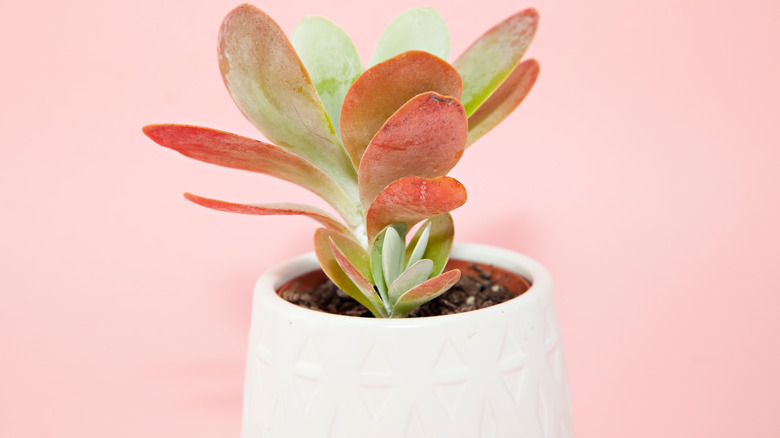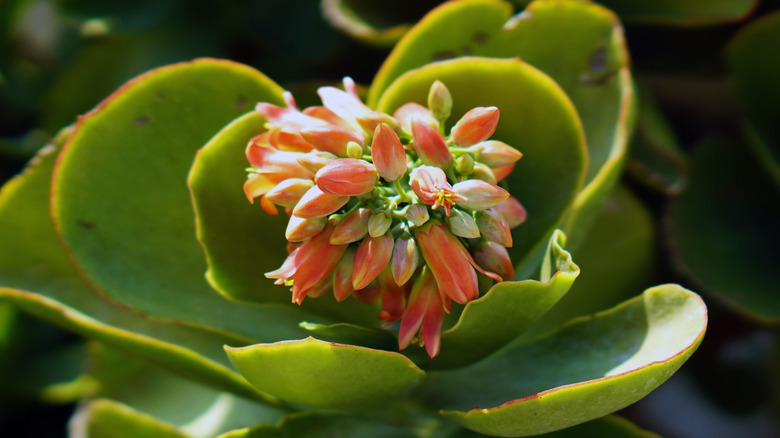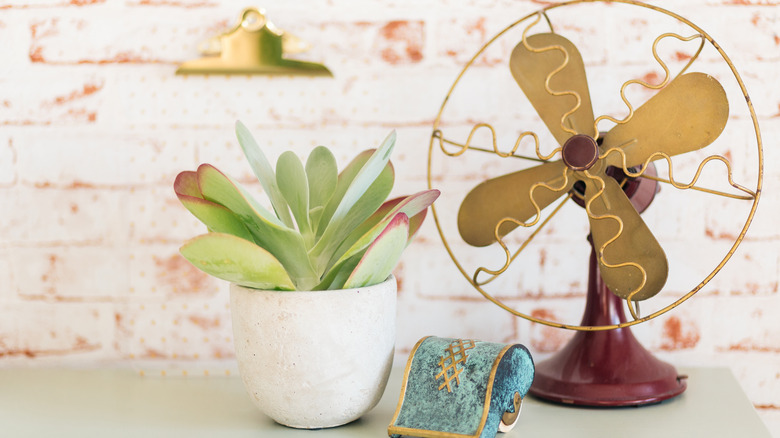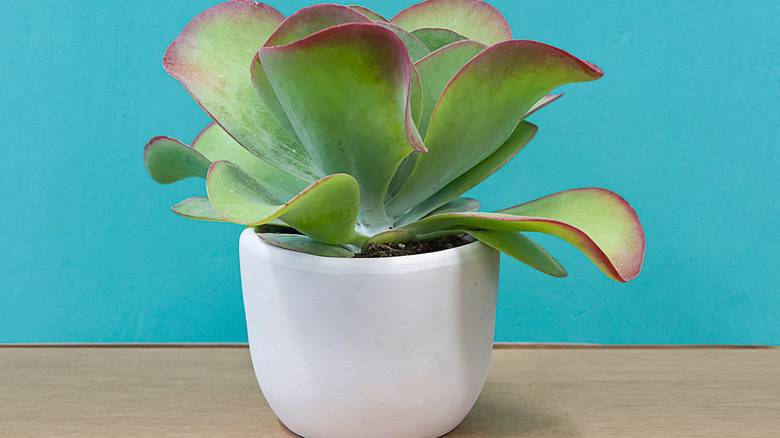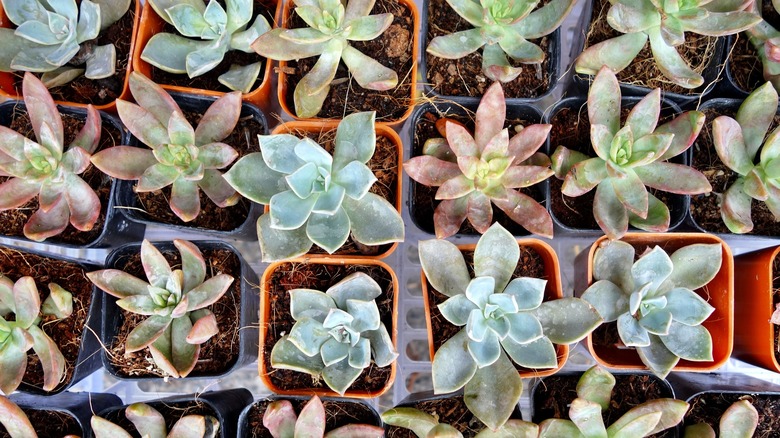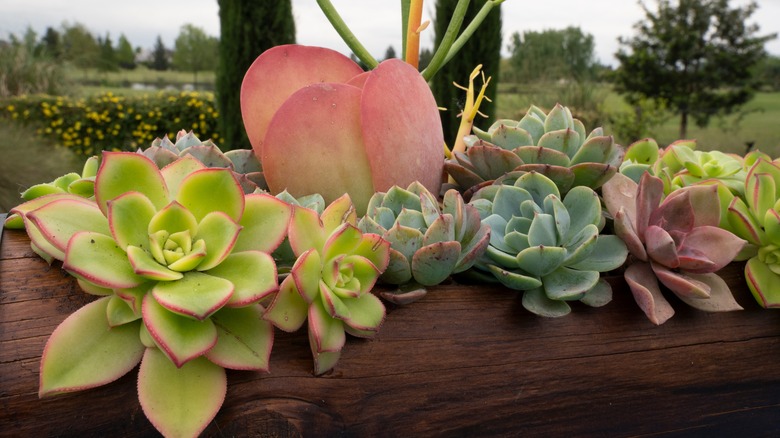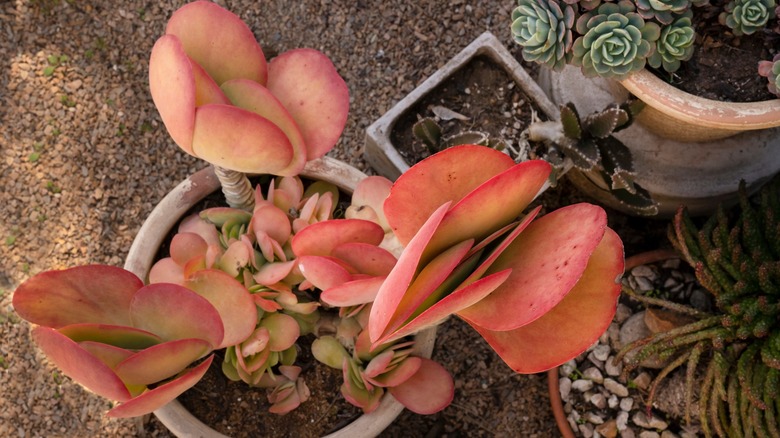How To Care For A Paddle Plant
The paddle plant, known botanically as kalanchoe luciae or kalanchoe thyrsiflora, is a type of succulent with long, rounded, paddle-like leaves. It is also commonly referred to as the flapjack plant for its round leaf shape. Native to South Africa, this succulent is a relative of the kalanchoe plant and can produce both the signature white, yellow-tinted flowers of the luciae species as well as the darker yellow flowers of the thyrsiflora species, according to The Spruce. Both varieties feature a white, waxy film on their leaves.
Although the luciae and thyrsiflora species are different in the way they flower, they are often mistaken for one another. Despite this, they have identical care needs and, for this reason, will be referred to interchangeably throughout this care guide.
Caring for a succulent may seem intimidating for some. However, as long as you are familiar with this plant's specific needs and implement a proper care regimen, it will thrive and reward you with flowers once it has matured. Read on to learn how to properly care for this unique succulent.
How to use paddle plant in garden
Succulents are most often accustomed to extremely hot and dry climates, which means their leaves grow in a way that promotes optimal water storage, as per Gardening Know How. As such, it is totally possible to use a paddle plant, among other succulents, to decorate your backyard during warmer months. The paddle plant can even be grown outdoors year-round in appropriate climates, growing best in USDA hardiness zone 10 or anywhere that doesn't get colder than 60 degrees, according to Gardening Know How.
Larger succulents are commonly used as eye-catching landscaping accents, but smaller succulents, like the paddle plant, are great for a succulent-specific garden. There are endless directions in which to take a succulent garden. Family Handyman recommends putting together a succulent mosaic, growing them over a fence, creating a miniature fairy garden, planting them in the gaps of your yard (the edge of a driveway, large cracks in the sidewalk, etc.), and, of course, in a rock garden. If you live in a colder climate, you can even plant them in clusters in beautiful pots to brighten up your patio — just remember to bring them indoors before it gets too cold.
How to grow paddle plant
Paddle plants are a popular succulent and can easily be found at most garden centers. However, they are also very easy to propagate, a practice that happens to benefit the plant's health as well, according to Joy Us Garden. Succulents tend to grow offsets along the stems, which can take away nutrients from the mother plant as it blooms. Paddle plants are also a little leggy, so cutting back mature stems and removing the offsets from the main plant helps maintain their health and appearance.
To get a paddle plant cutting, make sure the plant is healthy and has been recently watered. Using a clean and sharp knife or pruning shears, cut off a stem with a few leaves, and preferably a few budding offshoots, at the base.
Something unique to succulent propagation is letting the cuttings heal before planting them. Joy Us Garden recommends placing them in a well-lit room for two to three weeks until the cut area heals, which allows them to feed on their existing water source and prevents root rot. Once healed, remove the bottom leaves. Fill a small pot with cactus and succulent potting mix, add the plant, fill the rest of the pot with soil, and care for as usual. Just be careful to monitor the plant as it will be slightly more fragile and sensitive than normal.
How to care for paddle plant
Caring for paddle plants is as easy as caring for any other succulent. That being said, some houseplant enthusiasts have issues caring for succulents as they are much more tolerant of neglect than other popular houseplants and it can be hard to know when and how frequently to provide care. There's no need to fear, though, as it's quite simple once broken down.
According to The Spruce, paddle plants prefer lots of bright light but can survive in partial shade. The less light they get, though, the less likely they will be to flower. Additionally, their leaves may not develop the signature red lining in low light. Always make sure to monitor your plant when in the path of direct, hot sun, as the leaves may burn. Paddle plants do not like humid environments, so keep them out of naturally moist areas like bathrooms and away from other humidity-loving plants.
Many people struggle with how much water to give succulents as they don't require much. Remember that succulents are extremely drought tolerant and store water in their leaves. Let the soil of your paddle plant dry out completely between waterings and then heavily water, letting the excess drain out. As for fertilizing, feed every month to two months during spring and summer with a diluted liquid succulent or houseplant fertilizer.
Paddle plant varieties
Kalanchoe refers to a genus of succulents with roughly 120 species, according to Britannica. While paddle plants are among the most common species of kalanchoe, there are plenty of unique, interesting-looking varieties. Most are perennial and herbaceous while some exhibit annual growth patterns. Here are just a few more interesting varieties of kalanchoe from Debra Lee Baldwin:
-
Kalanchoe beharensis: Known commonly as Felt Bush, this succulent variety actually grows as a tree, featuring fuzzy, lettuce-shaped green leaves and a thin trunk.
-
Kalanchoe blossfeldiana: One of the most common varieties of kalanchoe, also known as Florist Kalanchoe, this species produces a bed of thick green foliage that supports its bright pink flowers.
-
Kalanchoe humilis: This is one of the rarer kalanchoe species, and it features bright red variegation in a tiger-stripe pattern.
-
Kalanchoe diagremontiana: Also known as Mother of Thousands and Devil's Backbone, this variety is marked by leaves with little buds growing along the edge, creating a sharp and spine-like effect.
-
Kalanchoe fedtschenkoi: Lavender Scallops, as it's also known, grows in a scalloped pattern while a purple-pink shade substitutes the classic red variegation.
Are paddle plants toxic?
Despite its breakfast-food nickname, the paddle plant is toxic to humans, cats, and dogs, according to Plant Care Today. As a matter of fact, all kalanchoe species are toxic, as noted by the ASPCA, due to the presence of a chemical compound known as bufadienolide. Symptoms of poisoning in pets can include vomiting, diarrhea, strained breathing, abnormal heart rate, weakness, collapsing, and even death. Make sure to keep this plant out of reach of your pet, especially if planting outside. If you suspect your pet has ingested a leaf or flower from your paddle plant, call your vet immediately. Consider bringing the plant along with you so they can run tests if need be.
Paddle plants are also toxic to humans, although it takes a significant amount of the plant to cause notable reactions, which include drooling, nausea, vomiting, and diarrhea. In more severe cases, you'll notice labored breathing, a rapid heart rate, and loss of consciousness. While you may know not to eat the plant, small and curious children may not, so it's best to keep it out of reach at all times. Paddle plants have also been known to cause irritation if the sap gets on your skin, so be sure to wear gloves when in contact with the plant (propagating, repotting, etc.), and always wash your hands after handling.
How to repot paddle plant
When you notice roots growing out of the bottom of your paddle plant's pot, you should start thinking about replanting. SFGate recommends transferring your paddle plant to a new container every 12 to 24 months in the spring. Begin by assessing the plant as is. If there is a long blooming stem, cut it down, as the plant will not begin the process of creating new flowers until that one has died. Pull the plant out of its current pot, using your fingers to gently massage the root system, and remove as much dirt as possible. You'll want to examine the root system at this point and remove any rotted or compacted roots.
Next, choose a pot up to 2 inches larger than the plant's current pot. Cover the base with a bit of cactus potting mix or a mix of potting soil and perlite, which will help increase drainage. You can also add sand for further drainage. Fill it up until the plant is at the same depth as it was in its old pot — you want the roots to be thoroughly buried, but the crown to be above the soil. Once in place, fill the rest with soil. Instead of watering it as you would with a houseplant, leave the paddle plant to rest for a week until it has used up its water reserves. Resume normal care after that week.
